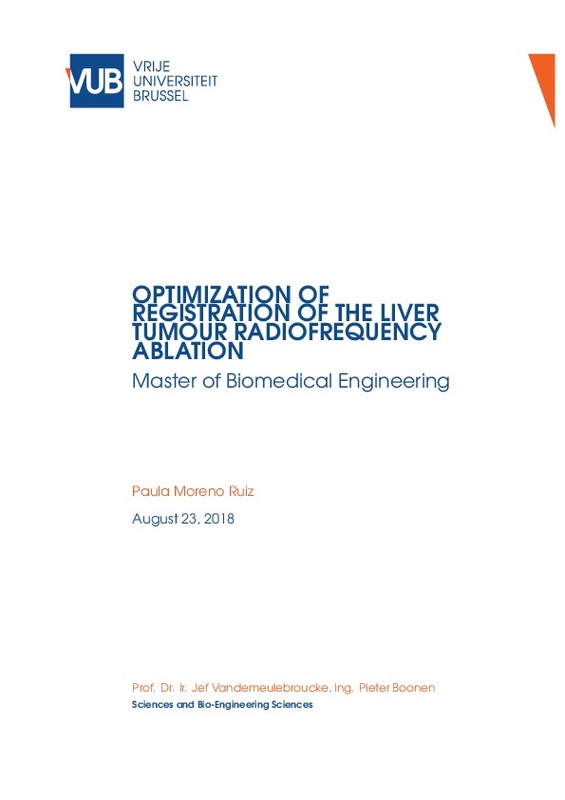|
Resumen:
|
[ES] El cáncer de hígado es uno de los cánceres más dañinos porque es un órgano vital del cuerpo. Existen múltiples métodos para tratar esta patología, siendo la cirugía la más importante. Sin embargo, no todos los pacientes ...[+]
[ES] El cáncer de hígado es uno de los cánceres más dañinos porque es un órgano vital del cuerpo. Existen múltiples métodos para tratar esta patología, siendo la cirugía la más importante. Sin embargo, no todos los pacientes pueden beneficiarse de ella debido a la edad o a las condiciones de salud. Gracias a su mínima invasividad, la ablación por radiofrecuencia (RFA) es una alternativa para algunos de estos pacientes porque la guía por imágenes precisas disminuye el riesgo de complicaciones.
Es importante elaborar un procedimiento que permita evaluar si la RFA de un tumor hepático tuvo éxito o si es necesario un tratamiento adicional como la cirugía. Aunque existen algunos estudios que evalúan el efectividad, muy pocos son reproducibles o eficientes, ya que utilizan segmentaciones manuales que consumen mucho tiempo. Por lo tanto, se realizó un registro de imágenes pre y post RFA en un grupo de 9 pacientes usando SimpleITK en python en imágenes TAC. A pesar de que el registro es un método útil para comparar estas dos imágenes, es un reto lograrlo de forma precisa. Requiere que coincida con cada vóxel del cuerpo del paciente, pero no con el tumor y la región de ablación.
El método propuesto consiste en una transformación rígida seguida de una transformación no rígida. Además, se estudió el uso de máscaras para obtener la solución más eficaz. Posteriormente, esta solución se mejoró afinando los parámetros de registro, como el espaciado de la rejilla y la penalización por flexión de la transformación. Finalmente, se realizó una evaluación exhaustiva para obtener la mejor afinación de los parámetros en base a la precisión y a las medidas de plausibilidad.
Para un conjunto de datos de 9 pacientes, se apreció cómo la calidad del registro aumenta con el aumento del espaciado de la cuadrícula de 15,0 a 10,0, y de 10,0 a 5,0 según el coeficiente DICE, los falsos negativos, los falsos positivos y el índice Jaccard. Sin embargo, el peso asignado a la penalización de la energía de flexión de transformación no tenía el mismo efecto Por tanto, no se pudo definir un efecto directo entre la calidad del registro y el aumento o disminución del peso asignado, incluso teniendo el mismo espaciamiento de la rejilla.
[-]
[EN] Liver cancer is one of the most harmful cancers because it affects a vital body organ. There are multiple methods to treat this pathology with surgery being the most effective. However, not all patients can benefit ...[+]
[EN] Liver cancer is one of the most harmful cancers because it affects a vital body organ. There are multiple methods to treat this pathology with surgery being the most effective. However, not all patients can benefit of it due to age or health conditions. Due to its minimal invasiveness, radiofrequency ablation (RFA) is an alternative for some of these patients because the precise image guidance decreases the risk of complications.
It is important to elaborate a procedure that allows to evaluate if either RFA of a liver tumour was successful or an extra treatment like surgery is necessary. Even though there are some studies that assess the effectiveness, very few are reproducible or efficient as they use manual segmentations which are time consuming. Therefore, a registration of pre- and post- RFA images in a group of 9 patients was performed using SimpleITK in python in CT images. Despite registration is a useful method to compare these two images, it is a challenge to achieve a precise registration. It requires to match each voxel of the body of the patient, but not the tumour and ablation region.
The proposed method consists of a rigid transformation followed by a non-rigid transformation. Moreover, the use of different masks were studied to get the most efficient solution. Subsequently, this solution was then improved by tuning the registration parameters such as the grid spacing and the transform bending energy penalty. Finally, an exhaustive evaluation was performed in order to obtain the best parameter tuning basing on the accuracy and the plausibility measures.
For a dataset of 9 patients, it was appreciated how the quality of registration increases by the rise of the grid spacing from 15.0 to 10.0, and from 10.0 to 5.0 according to dice coecient, false negatives, false positives and jaccard index. However, the weight assigned to the transform bending energy penalty had not the same effect. It could not define a direct effect between the quality of the registration and the increase or decrease of the weight, even having the same grid spacing.
[-]
|







